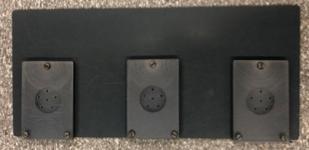Methods
Participants
A total of 37 owners and 42 dogs were recruited for this study.
- 24 dogs of ancient breeds
- 18 dogs of independently working hunting breeds
Unsolvable problem task

The dogs were presented with an apparatus with three compartments, each containing treats and covered by a plastic lid with holes for olfaction purpose. The two outer compartments could easily be slid open by the dogs in order to gain access to the treats, while the one in the middle was screwed down and impossible to open by the dogs - thus making the task unsolvable. Human-directed behaviours such as physical contact, proximity and eye contact were scored for three minutes.
Long-term stress
For each household, hair samples were collected from the dog(s), the owner of the dog and from one extra adult person. The dog hair was cut from the neck as close to the skin as possible, and the human hair was cut from the posterior vertex of the head as close to the scalp as possible. From each hair sample, the two centimetres closest to the hair follicle were analysed using radioimmunoassay in order to reflect the individuals cortisol levels during the latest 2-3 months.
Owner-based questionnaires
All owners answered a total of 4 questionnaires
- Monash dog owner relationship scale (MDORS), about their perceived relation to their dog
- Big Five Inventory, about the owner’s personality
- Dog Personality Questionnaire, about the dog’s personality
- Lifestyle
On this page, I will only mention the results from the MDORS. To learn more about the results from the other questionnaires - click on "contact & downloads" in the menu to the left where you will find a link to my full master thesis project.
Responsible for this page:
Director of undergraduate studies Biology
Last updated:
05/22/20
